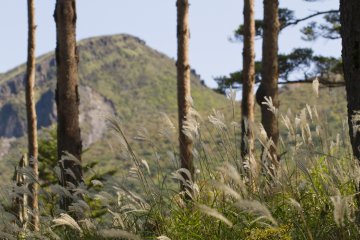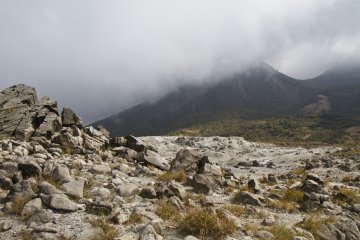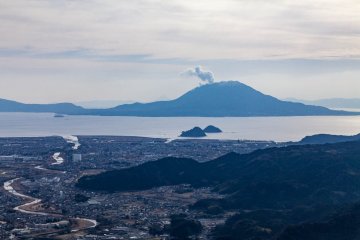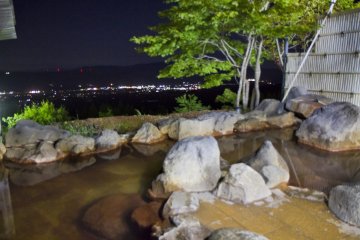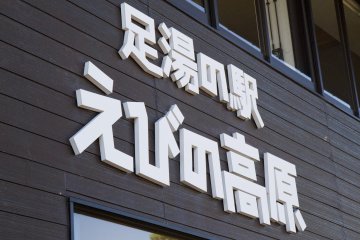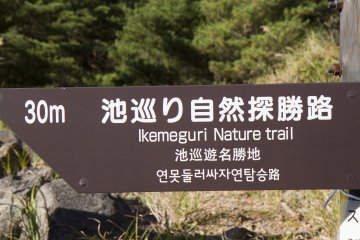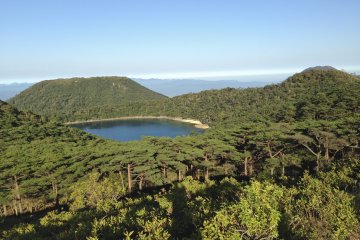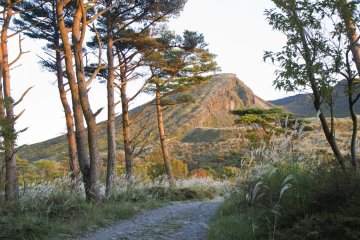The wonders of Kirishima-Kinkowan National Park might begin with this splendid short-to-medium hike. For a full circle hike around the three volcanic crater lakes, you’ll need about two hours. Begin at the Ebino Kogen Museum Center, where there’s a (pay) parking lot, a souvenir shop, an outdoor footbath, and a visitor’s center (map). The campground is filled with nature, too, and is only a ten-minute walk from here.
Signs in the parking lot point you to the trailhead. Heading toward Byakushi Pond first and taking the trail clockwise, you’ll walk up from the 1,200 m (3,937 ft) plateau a little and into a forest. You’ll get periodic views of the surrounding peaks of Mt. Shiratori (which has a nice onsen on the other side), the more distant and flat-topped Mt. Koshiki, the sulfur-littered landscape of Mt. Io, and the dominant and oddly-shaped Mt. Karakuni.
Take the slight diversion from the trail circling Byakushi Pond upwards toward Mt. Shiratori for a birds-eye view of the pond as well as Rokukannon Pond and Mt. Koshiki behind it. As you emerge from the forest, you’ll notice more miyama kirishima—Kyushu azaleas (a highly-regarded kind of tsutsuji native to this region). They occupy the sunnier, more exposed areas in higher elevations, and cover the mountainsides in pink blossoms during May and June.
Inside the woods, notable trees include Japanese red pines (akamatsu). Deer thrive here and can even be seen grazing during the daytime. Keep your eyes open for other small mammals, such as field mice and tanuki, or raccoon-dogs, particularly near dusk.
After rounding Byakushi Pond, you’ll begin to encircle the larger Rokukannon Pond. Along the shoreline, you’ll pass right through the grounds of the deep red Rokukannon Shrine. A nice resting place, there are some noteworthy ancient trees here (one Japanese cedar, or sugi, is over 500 years old) and excellent views of the lake. Birds are common throughout the hike, but especially from here to the end of the section rounding this pond. A pair of binoculars or a camera with a healthy zoom lens will come in handy.
The third and final crater lake is Fudo Pond. Here the landscape flattens out into a grassy plain. In the autumn, the beautiful tufts of susuki, also known as Japanese pampas grass, add drama to the scene and glow when backlit by the sun.
A road passes by this lake. You can cross the road and start a hike that goes up Mt. Io for a sulfuric adventure and scenic fields, and even on to Mt. Karakuni and beyond. Or you can continue the clockwise trail, parallel to the road, back to the visitor’s center.
霧島錦江湾国立公園—Kirishima-Kinkouwan Kokuritsu Kouen—Kirishima-Kinkowan National Park えびの高原池巡り自然探勝路—Ebino Kogen Ikemeguri Khizen Tanshou-ro—Ebino Plateau Ikemeguri Nature Trail 白紫池—Byakushi-ike—Byakushi Pond 甑岳—Koshiki-dake—Mt. Koshiki 六観音御池—Rokukannon-miike—Rokukannon Pond 不動池—Fudou-ike—Fudou Pond



